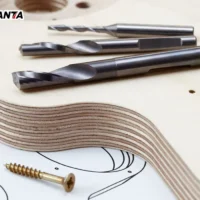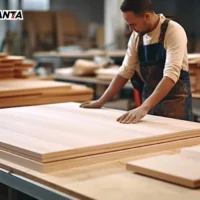Commercial plywood is a popular choice for furniture, cabinets, and interior decor. Known for its affordability and versatility, it suits various applications and budgets. In this guide, we’ll cover what makes commercial plywood distinct, explore common types, and review available sizes.
What is Commercial Plywood?
Commercial plywood is a type of plywood primarily used in furniture and interiors. It is made by layering thin sheets of wood, called veneers, in alternating grain directions. This layered structure enhances strength and reduces expansion and contraction due to temperature or moisture changes.
Commercial plywood is preferred for indoor use due to its balance of quality and cost. Unlike marine plywood, commercial plywood is not waterproof and suits dry areas better.
Benefits of Using Commercial Plywood
There are several benefits to using commercial plywood. These advantages make it a popular material in construction, furniture making, and interior decor.
- Affordability: Commercial plywood costs less than other types, like marine or birch plywood.
- Lightweight and Strong: It’s strong enough for basic furniture and light structures.
- Easy to Work With: Its smooth surface and flexible structure make cutting and shaping easy.
- Eco-Friendly Options: Many manufacturers offer eco-friendly commercial plywood made from renewable sources.
Common Types of Commercial Plywood
Commercial plywood is available in several types, each with unique features. Here, we’ll explore the most common types to help you choose the right plywood for your needs.
1. Moisture-Resistant (MR) Grade Plywood
MR grade plywood is made with a glue that resists moisture to some extent. However, it’s not fully waterproof, making it ideal for indoor furniture and spaces like living rooms and bedrooms. This plywood type is budget-friendly and works well for basic furniture or decorative panels.
2. Fire-Retardant Plywood
Fire-retardant plywood is treated with chemicals to reduce fire risks. This type is typically used in public spaces, such as schools, hospitals, and commercial buildings. While it is slightly more expensive than standard plywood, fire-retardant plywood provides essential safety benefits in high-risk areas.
3. Flexible Plywood
Flexible plywood, also known as “flexi ply,” is designed to bend easily. It’s ideal for making curved furniture, arches, or round columns. This type of plywood is particularly popular among furniture designers who want to create unique shapes and designs.
4. Calibrated Plywood
Calibrated plywood is manufactured with a consistent thickness throughout. This feature makes it suitable for applications requiring uniform thickness, such as modular furniture and kitchen cabinets. Calibrated plywood is more precise and provides a smooth finish, which reduces the need for additional sanding.
5. Softwood vs. Hardwood Plywood
Commercial plywood can also be categorized based on wood type. Softwood plywood, such as pine, is lighter and often used in construction projects. Hardwood plywood, made from woods like teak or oak, is more durable and is usually found in furniture and decor items. Softwood plywood suits temporary structures, while hardwood plywood is better for long-lasting furniture.
Available Sizes of Commercial Plywood
Understanding plywood sizes is essential for choosing the right product for your project. Standard plywood sheets come in various thicknesses, lengths, and widths. Let’s break down the most common sizes.
1. Standard Sheet Sizes
The most common plywood sheet size is 4×8 feet, which is convenient for both small and large projects. This standard size works well in most applications, whether you’re building furniture or working on a small DIY project.
2. Custom Sizes
Many suppliers offer custom sizes upon request, catering to specific needs. For example, builders working on unique projects may order 5×5 feet or larger sheets. Custom sizes are ideal for reducing material wastage and matching specific design requirements.
3. Plywood Thickness Options
Commercial plywood is available in thicknesses ranging from 3mm to 25mm. Thinner sheets, such as 3mm and 6mm, are suitable for decorative purposes or lightweight furniture. Thicker options, like 12mm and 18mm, are stronger and ideal for structural applications, including cabinets and shelving.
Choosing the Right Commercial Plywood for Your Needs
With various options in commercial plywood, selecting the best type for your project may seem challenging. Here are a few considerations to help you make an informed decision.
- Consider the Environment: If the plywood will be used in a dry indoor area, MR grade plywood works well. For humid areas, you may consider using moisture-resistant or treated plywood.
- Assess the Load Requirements: For load-bearing structures, choose thicker plywood, such as 18mm or 25mm sheets. For decorative items, thinner sheets are generally sufficient.
- Budget and Durability: Commercial plywood is generally affordable, but options like calibrated and fire-retardant plywood may cost more. If durability is essential, investing in higher-grade plywood is worthwhile.
Frequently Asked Questions about Commercial Plywood
Q: Can commercial plywood be used for outdoor projects?
A: Commercial plywood is not designed for outdoor use. Exposure to moisture can cause warping and damage. For outdoor projects, consider using marine plywood.
Q: What is the lifespan of commercial plywood?
A: With proper care, commercial plywood can last for years, especially if used indoors. Keeping it away from moisture will extend its lifespan.
Q: How is commercial plywood different from marine plywood?
A: Marine plywood is waterproof and ideal for outdoor or wet areas. Commercial plywood, on the other hand, is not waterproof and is better suited for indoor projects.
Q: Is there an eco-friendly option for commercial plywood?
A: Yes, many manufacturers now offer eco-friendly commercial plywood made from sustainably harvested wood and non-toxic adhesives.
Conclusion
Commercial plywood offers a reliable, affordable solution for interior projects, ranging from furniture to home decor. With various types like MR grade, fire-retardant, and flexible plywood, finding the right option for your needs is straightforward. When selecting plywood, consider the environment, load requirements, and your budget to make the best choice. Whatever your project may be, commercial plywood provides versatility, affordability, and style for a range of interior applications.






















1 Comment